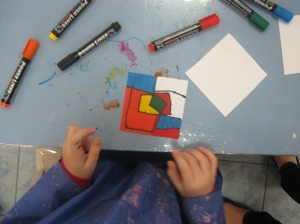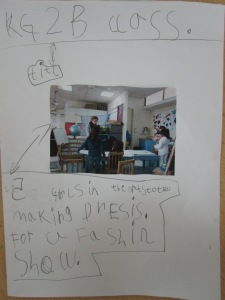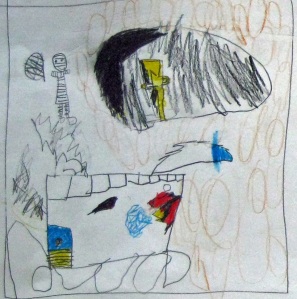“KG2B Class” Newspaper

These two students started the day with Lego “cameras,” and ended it with a four-paged newspaper. When I offered them the use of our class camera, they were excited to take pictures of everyone in the class. They took photos of people working in various parts of the classroom, printed and cut them, and arranged them according to how many people were engaged in each activity. After noticing that they only had 4 pages to work with, but five stories, they looked to The Daily Star, Lebanon’s English newspaper, and determined that they could include more than one story on each page, as long as there was a line separateing each story. They wrote a short synopsis of the event, and asked for the names of the projects people were working on. The newspaper, “KG2B Class” was well received by classmates as it passed around from one person to the next.
“5 girls in the art studio making dresses. For a fashion show.”
“They’re building a ‘Folum.'”
“Three people working in the writing [center].”
“They’re cleaning up the blocks.”
 After noticing that a handful students were “stuck in a rut,” drawing the same subject, rushing, or using a select few colors, I wondered if changing the materials available to them would provoke a different kind of work or a different way of working. I decided to cut standard size printer paper in half. Then I cut it in half again.
After noticing that a handful students were “stuck in a rut,” drawing the same subject, rushing, or using a select few colors, I wondered if changing the materials available to them would provoke a different kind of work or a different way of working. I decided to cut standard size printer paper in half. Then I cut it in half again.
Working with these small papers, I noticed that students were spending more time on their drawings than they had with paper four-times its size. Pictures were more detailed, and many students filled in the entire paper, which only happened occasionally with the bigger size. Could something as simple as changing the paper size transform the way students work?

This got me thinking in a different way. Sometimes when we talk about giving children quality materials, I assumed that the more space they have the better. For students who plan to spend a long time on detailed work that uses every centimeter of paper, are we doing them a disservice by presenting them with large paper? For children who are exposed to quality art through books and galleries, can we make their goals more achievable by presenting them with smaller paper?
I’m still here.
I hope that 2011 will bring a year of more consistent blog posting for me. I won’t lie. I haven’t thought much about this space in the last month or so. We’ve got a lot to talk about.


Above: Tiger Houses
Ambition and Confidence
This picture made me think about the way children relate to images, and in particular, images of themselves. PH brought this picture of himself to school, and wanted to put it on our wall.
I could be for Spain – I could hit the ball with my head and score 3 times. We won! I think that I could be Spain.
PH genuinly believes he will play professional football someday. I admire the unfettered ambition of many students. When children believe in their skills, I hear confident declarations, “I am an artist” or “I am a football player.” It seems that they rarely doubt themselves and their abilities if they have these ideas in their minds. As a result, many push themselves to become better and develop new skills.
Sometimes fostering this confidence is simply a matter of acknowledging and taking interest in the work of the child.
Having Space
The class visited Beirut’s newest art gallery, the Beirut Exhibition Center, last week to see the Arabicity exhibit. The collection was impressive in its diversity of work, and the space was unlike any we’ve visited as a class.
After looking around, we asked students to pick something that interested them, and to sketch a picture of it. It was calming to watch students sit down, really sharing a moment with the art they were experiencing. In taking these photos, though, I did feel a little bit like I was violating private moments. It was like I was spying on some kind of relationship that was forming in front of me between students and the art – something that was personal and none of my business.
When we’re in class, there’s always someone else nearby – every moment is a social moment. This reflects our beliefs about social constructivism, but witnessing these private, personal moments made me think about having space and being alone. I don’t often see this in school because rarely do students have the opportunity to be alone.
The Rabbit
Nadia: Ms. Lauren! The rabbit’s telling me secrets!
Me: Really Nadia?! What’s she saying?
Nadia: She said, “Nadia, Nadia! You’re MARVELOUS!”
This is the rabbit that visited our class. She came from another KG2 class, and we invited her to stay in our room for the week. Other than Spider, our class fish, we have never had a class pet. I’ve generally thought it would be more work than reward, and not given it any thought after that.
What I saw last week changed my mind. It was incredible to see which children were hesitant to approach, and which ones wouldn’t leave its side. I saw overwhelming empathy where I didn’t think it existed, and several students kept coming up to the room from recess (ahem, without asking) to check on her. By the end of the week, when the rabbit passed by, many students might smile and say something to her, and then continue their work. the rabbit was hopping right into our “planning time,” and I heard someone make a joke, saying, “OK rabbit, what do you want to do today?!”
Children read to the rabbit and were very gentle, and she added an extra element to the classroom that I miss now that she’s back home in her classroom. We’re on the lookout and hoping to adopt a rabbit of our own soon.
Above: Students read with the rabbit on the couch; a playhouse for the rabbit when he’s hopping around.
Humor and Blocks
Rough Play
We’ve had quite a bit of rough play among many of the students in the classroom, mostly sparked by an interest in wrestling by a few. I’ve had a few conversations with colleagues about the subject of developmentally appropriate rough play among 5-year-olds. While most have agreed that rough play is part of a child’s development, there are mixed opinions about whether or not this can be incorporated into the classroom. It is our job to provide activities and materials for the development of children, but is it possible to safely incorporate rough play into a classroom with 21 children and two teachers?
The parents were here on Monday for a group meeting, and I’m grateful that we were able to have a fruitful conversation about the topic. Many of the parents are also concerned about the subject of rough play, and it was nice to make some decisions together, as a community, about what we can do to keep everyone safe. I’m proud to be a part of a group that is willing to discuss our opinions and questions about children.





















